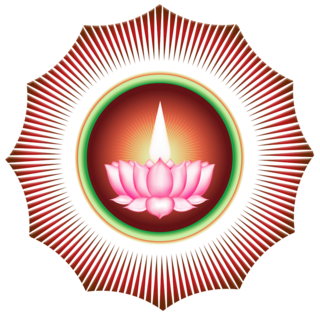
Ayyavazhi is a Hindu denomination that originated in South India during the 19th century.

Nizhal Thangal also called Inai Thangals) are secondary worship places of the Ayyavazhi, often smaller in size than Pathis, built per the instructions of Akilattirattu Ammanai. Cleanliness is strictly enforced.

Pathi is the name of the primary centres of congregational worship for the South Indian religious system of Ayyavazhi, having a relatively large structure like that of a temple. They are seven in number.

Mutta Pathi, is one of the Pancha pathi, which are the primary centers for worship of the Ayyavazhi. This is the third important pilgrim center of Ayyavazhi. This place earn the religious importance in Akilam from the event that, Ayya Vaikundar is given two Vinchais here by Narayana under the Sea; One just before the arrest of Vaikundar by Swathi Thirunal and the second after the completion of Thuvayal Thavasu.

Thamaraikulam Pathi, is one among the Pancha pathi, the five holy places of Ayyavazhi. The Ari Gopalan Citar, who wrote the Akilam was born here.

Poo Pathi is one among the Pancha pathi, which are the primary worship centers and holy places of Ayyavazhi. As the incarnational activity of Vaikundar, the marriage with Poomadanthai, the Goddess of Earth was the event took place here. This Poomadanthai was the final deity unified by Vaikundar into himself, symbolizing the destruction of Kali from the world (earth).

Pancha pathi are the five important pilgrim centers of Ayyavazhi. These are also considered as the primary Pathis and as worship centers of Ayyavazhi with primary status. The first pathi is Swamithope pathi itself and is the headquarters of Ayyavazhi. The other Pathis are Muttappathi, Thamaraikulam Pathi, Ambalappathi and Pooppathi.

The Arul Nool is a supplement to the Akilattirattu Ammanai, and is likewise considered a holy scripture of Ayyavazhi. This book contains the collection of messages given by Ayya Vaikundar to his Disciples, whose names are unknown. Since they are believed to be composed by Arylalarkar, it acquired the name Arulnool. There is no direct indication within the book regarding the time of its composition.
According to Akilattirattu Ammanai, the scripture of the Ayyavazhi religion, Ayya Vaikundar, the Incarnation of Lord Narayana in Kali Yukam, has five Seedar (disciples). They were in the previous Dwapara Yukam as Pandavas who were transmigrated as disciples of Vaikundar in this Yuga.

The Pathis and Nizhal Thangals, are centers of worship and religious learning for the followers of Ayyavazhi which are established in different parts of India. They served as centres for propagation of the beliefs and practices of Ayyavazhi. There are more than 8000 worship centers throughout India, mostly in Tamil Nadu and Kerala. The Pathis are given religious importance than the Nizhal Thangals and are considered as primary worship centers. Since Ayyavazhi is not an organised religion, Swamithoppepathi serves, religiously but not officially, as the headquarters of all.

The Ayya Vaikunda Avataram or Vaikunda Jayanthi is a festival celebrated by the followers of Ayyavazhi on the 20th day of the Tamil month of Masi, the date on which the Ayyavazhi followers believe that Lord Narayana himself incarnated as Vaikundar during an encounter with a deity Goddess Lakshmi, he was beget inside the sea and arose from the sea of Thiruchendur on Kollam Year 1008 at 20th day of Tamil Month Masi. He took the human form as Narayana Pantaram at Tharuvaiyur near seashore to destroy the evil spirit of Kali and transform the Kaliyukam into Dharma Yukam.

The following outline is provided as an overview and topic guide to Ayyavazhi:

The Ayyavazhi symbolism deals with the symbols which are used in or used to represent Ayyavazhi. Though Akilam the scripture of Ayyavazhi does not point out any symbol directly, there are a few symbols which are used for representing Ayyavazhi which came into practice gradually.

The purpose of this chronology is to give a detailed account of Ayyavazhi from the beginning of the incarnational events of Vaikundar to the present time. Question marks on dates indicate approximate dates. A star (*) indicates the mentioning of that particular date in Akilam or Arul Nool. All dates but a few are found in the Tamil calendar and so doesn't coincide exactly with the months of the Gregorian calendar. The dates may span over any halves of the two consecutive months (Gregorian).

An Ayyavazhi wedding is the wedding custom within the Ayyavazhi belief system of South India. Usually Dharmagharttas, Panividaiyalars from Thangals or an older person experienced in Ayyavazhi assumes a role as a Guru and is seated in the Manvarai for leading the wedding ceremony.

Ayyavazhi phenomenology is the phenomenological variations found in Ayyavazhi society, worship centers etc. from their holy text Akilattirattu Ammanai.
Anbukkodimakkal Thirucchabai is a democratic bureau established by the religious headquarters of Ayyavazhi in the late 20th century. It was one among the latest developments in the religious history of Ayyavazhi.
The Vaikunda Malai is a hill which is part of the Mahendragiri Hills situated near Athala vilai of Kanyakumari district in the Western Ghats of India. This hill has religious importance in the Ayyavazhi religion during the festival of Ayya Vaikunda Avataram, the day of incarnation of Ayya Vaikundar.

The festivals and celebrations play an important role in the socio-religious universe of Ayyavazhi. Some of the festivals are common for both Pathis and Nizhal Thangals, while some are confined to Pathis. In Swamithope pathi, every day is celebrated as a festival with the name 'Nitham Thirunal'. Normally all the festivals are celebrated grandly in Swamithope than any other worship centers of Ayyavazhi. LMS reports to witness such festivals.

Swamithoppe Pathi is the primary pathi of the Ayyavazhi, and the sacred venue of the Tavam. Religiously Swamithope is considered primary among the Pancha pathi and the primary centre of the incarnational activities of Vaikundar.




